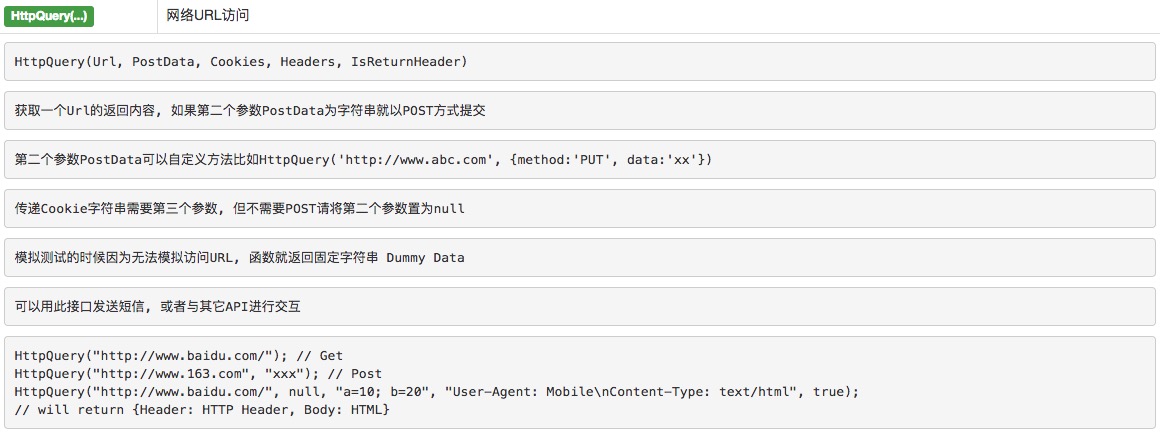2.14 Wie kann die API der Börse aufgerufen werden?
Schriftsteller:Die Erfinder quantifizieren - Kleine Träume, Erstellt: 2017-05-02 11:53:48, Aktualisiert: 2017-10-11 10:23:022.14 Wie kann die API der Börse aufgerufen werden?
-
HttpQuery-Funktionen

Bei Anrufen von Authentifizierungslosen API's (z. B. API's für Marktinformationen, die nichts mit Kontoinformationen zu tun haben), wie:
https://www.okcoin.com/api/v1/future_estimated_price.do?symbol=btc_usd // 获取交割预估价HttpQuery (WEBhttps://www.okcoin.com/api/v1/future_estimated_price.do?symbol=btc_usd”)
https://www.okcoin.com/api/v1/future_hold_amount.do?symbol=btc_usd&contract_type=next_week // 获取合约持仓量HttpQuery (WEBhttps://www.okcoin.com/api/v1/future_hold_amount.do?symbol=btc_usd&contract_type=next_week”)
Das Ergebnis ist eine String in JSON-Format, die mit der JSON.parse-Funktion als Objekt analysiert und Daten erhalten kann.
-
exchange.IOFunktionen

Die Exchange-APIs, auf die IO-Funktionen aufgerufen werden, müssen verifiziert werden (nicht unterstützt).
Die spezifische Verwendung ist in der API-Dokumentation zu finden.
- BitMEX exchange API note BitMEX Exchange API Nutzungsbedingungen
- Die Extreme im Trendhandel werden aufgedeckt
- Wie man mit dem Code genau anpasst, wie man das System für die Anpassung an das Standard-System für die Anpassung an das Standard-System für die Anpassung an das Standard-System für die Anpassung an das Standard-System für die Anpassung an das Standard-System für die Anpassung an das Standard-System für die Anpassung an das Standard-System für die Anpassung an das Standard-System für die Anpassung an das Standard-System für die Anpassung an das Standard-System
- Hochfrequenzstrategie
- Die klassischen Fehler von Optionen für Neulinge
- Wie wurde die Strategie Nummer eins des Bitcoin-Hochfrequenz-Harvesters umgesetzt?
- Ein tieferes Verständnis für alle Interessengruppen im Futures-Markt
- Der Trend ist zurück zu treten.
- Drei Grafiken zum Lernen von Maschinen: Grundkonzepte, fünf Typen und neun Algorithmen
- Die Konsistenz der Spaltungen entscheidet, ob sie profitabel oder nicht
- Was halten Sie von den aktuellen Ethereum- und Ethereum-Plattformen?
- Null
- Sechs Tipps, wie Sie Ihre Futures über Nacht aufbewahren können
- Goldstein-Gutes über Nacht-Futures (Trend-Trading)
- Ein Spielzeuggedanken
- Die Geheimnisse des Freizeitlebens
- Die Sharp-Rate ist 0,6. Soll ich sie aufgeben?
- Die Abstimmungsstrategie ist nicht die Zeit, die es braucht, um zu entscheiden, ob es besser ist oder nicht.
- Kann ich eine Beschreibung der Parameter für die Re-Test-Ergebnisse geben?
- Die Zukunftsgeschäfte sind nicht zu vernachlässigen
QQ47898077 因为python不支持HttpQuery,exchange.IO又必须要验证,所以我尝试用自带的urllip获取行情信息。但是Poloniex的API都有人工验证,你们是怎么解决的呢。
Die Erfinder quantifizieren - Kleine TräumeIch bin auch auf gihub und lerne immer noch: Ich weiß nicht. def _call ((self, mode, uri, data = None): url = '%s://%s%s' % (SCHEME, self._host, uri) # Log ((Mode +'' + url) # print Siehe auch: Das ist nicht wahr. Requests (url, data = data, headers = headers, method = mode) # Log (("req:", req) # print Mit request.urlopen ((req, timeout=TIMEOUT) als Resp: Wenn resp.getcode (()!=200: raise ApiNetworkError (('Bad response code: %s %s' % (resp.getcode(), resp.reason)) return resp.read ((() # self._parse ((resp.read (()) Ich weiß nicht. Senden Sie eine Anfrage.